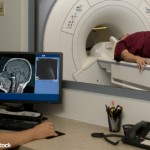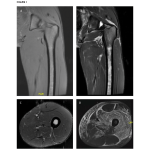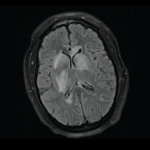In individuals without radiographic knee osteoarthritis (OA), Chang et al. investigated whether magnetic resonance imaging (MRI) defined knee OA at baseline was associated with incident radiographic and symptomatic disease during up to 11 years of follow-up. The researchers found the two current MRI definitions of knee OA may not adequately predict the development of radiographic and symptomatic disease.
Chronic Back Pain & axSpA
Maksymowych et al. assessed the frequency of axial spondyloarthritis (axSpA) according to extra-articular presentation and human leukocyte antigen B27 (HLA-B27) status and sought to identify features that distinguish patients with axSpA from those with non-specific back pain. Their data support recommendations that patients with chronic back pain and extra-articular features related to axSpA be screened for axSpA with MRI and referred to a rheumatologist.

Do NSAIDs Mask MRI Findings in Patients with Axial Spondyloarthritis?
Research suggests the use of non-steroidal anti-inflammatory drugs may mask the amount of sacroiliac joint inflammation found on MRI in patients with axial spondyloarthritis.
Sacroiliitis on MRI: axSpA or Another Cause?
Magnetic resonance imaging (MRI) is the gold standard imaging modality for the detection of sacroiliitis, a hallmark of axial spondyloarthritis (axSpA). However, the specificity of MRI for axSpA has been questioned. Renson et al. found that structural MRI-detected SI joint lesions are frequently seen in healthy individuals.

In the Bones: RheumMadness 2022 False Positive MRI in Axial SpA
Spondyloarthropathy (SpA) can be difficult to diagnose, with rheumatologists sometimes relying on classification criteria designed for clinical trials. Research examines how the use of MRIs affects the finding of bone marrow edema and the diagnosis of axial SpA.
According to MRI, Ultrasound Guidance Does Not Improve Treat-to-Target in RA
NEW YORK (Reuters Health)—Ultrasound guidance does not improve the effectiveness of treat-to-target therapy in rheumatoid arthritis (RA), new findings confirm. “Incorporating ultrasound information in treatment decisions did not lead to reduced MRI inflammation or less structural damage compared with a conventional treatment strategy,” Dr. Ulf Sundin of Diakonhjemmet Hospital, Oslo, and colleagues write in Rheumatology….

MRI-Guided Therapy Offers No Improvement Over Conventional Treat to Target for RA
New research does not support the use of a magnetic resonance imaging (MRI)-guided strategy for treating RA patients. The study found that among RA patients in remission, an MRI-guided treat-to-target strategy compared with a conventional treat-to-target strategy did not result in improved disease activity remission rates or reduced radiographic progression…

Case Review: MRI Leads to Non-Rheumatic Diagnosis Surprise
Rheumatologists often rely on magnetic resonance imaging (MRI) in the evaluation of suspected muscular diseases. Here, we describe a case in which unexpected findings on MRI pointed to a diagnosis rarely considered as a mimicker of rheumatologic disease. The Case A 19-year-old man of Middle Eastern descent was admitted to our hospital for evaluation of…
Getting Past the Noise to Identify SpA
Objective: Low-grade bone marrow edema (BME) has been reported in the sacroiliac (SI) joints of 25% of healthy individuals and patients with nonspecific mechanical back pain, thus challenging the specificity and predictive value of magnetic resonance imaging (MRI) for the identification of early spondyloarthritis (SpA). It is unknown whether stress injury in competition sports may…

Case Review: Lupus Patient with Acute Disseminating Encephalomyelitis
Systemic lupus erythematosus (SLE) is an autoimmune-mediated rheumatic disease characterized by multisystem involvement that can cause significant morbidity and mortality. Acute disseminated encephalomyelitis (ADEM) is a rare, fulminant, autoimmune-mediated, demyelinating disease involving the white matter of the central nervous system (CNS), and is considered a manifestation of neuropsychiatric lupus. Few reported cases involve SLE and…
- 1
- 2
- 3
- 4
- Next Page »